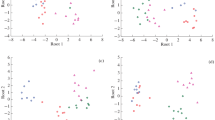Abstract
Mice were pretreated with the monoamine oxidase inhibitor nialamide, and sixteen hours later the dopamine (DA) β-hydroxylase inhibitor, bis-(4-methyl 1-homopiperazinylthiocarbonyl)-disulfide (FLA-63) or the tyrosine hydroxylase inhibitor α-methyltyrosine methylester (H44/68) was given. At different time intervals motor activity was measured and the brain levels of noradrenaline (NA) and DA were subsequently determined. Nialamide increased both motor activity and amine levels. Chlorpromazine changed this hypermotility into a marked hypomotility. After FLA-63 the NA level was moderately reduced whereas DA remained high and motor activity was only slightly reduced. When H44/68 had been given both NA and DA levels were reduced while a definite reduction in motility could be observed. In these nialamide pretreated animals the synthesis inhibitors reduced catecholamine levels and motility much less than in normal animals. In separate experiments the degree of synthesis inhibition under the conditions described above was measured by estimation of the amount of 3H-DA and 3H-NA formed from 3H-tyrosine. It was concluded that both NA and DA are of importance in controlling motor activity.
Similar content being viewed by others
References
Andén, N.-E., Corrodi, H., Fuxe, K., Hökfelt, T.: Increased impulse flow in bulbospinal noradrenaline neurons produced by catecholamine receptor blocking agents. Europ. J. Pharmacol.2, 59–64 (1967).
Andén, N.-E., Roos, B.-E., Werdinius, B.: Effects of chlorpromazine, haloperidol, and reserpine on the levels of phenolic acids in rabbit corpus striatum. Life Sci. 3, 149 to 158 (1964).
Bertler, Å., Carlsson, A., Rosengren, E.: A method for the fluorimetric determination of adrenaline and noradrenaline in tissues. Acta physiol. scand. 44, 273–292 (1958).
Carlsson, A.: Brain monoamines and psychotropic drugs. Neuro-Psychopharmacol. 2, 417–421 (1961).
—, Fuxe, K., Hökfelt, T.: Failure of dopamine to accumulate in central noradrenaline neurons after depletion with diethyldithiocarbamate. J. Pharm. Pharmacol. 19, 481–483 (1967).
—, Lindqvist, M.: In-vivo decarboxylation of α-methyl DOPA and α-methyl metatyrosine. Acta physiol. scand. 54, 87–94 (1962).
— —, Magnusson, T.: On the biochemistry and possible functions of dopamine and noradrenaline in brain. In: Ciba Symposium on Adrenergic Mechanisms, pp. 432–439. Ed.: J. R. Vane, G. E. W. Wolstenholme, and M. O'Connor. London: J. & A. Churchill Ltd. 1960.
—, Waldeck, B.: A fluorimetric method for the determination of dopamine (3-hydroxytyramine). Acta physiol. scand. 44, 293–298 (1958).
Corrodi, H.: Blockade of the psychotic syndrome caused by nialamide in mice. J. Pharm. Pharmacol. 18, 197–198 (1966).
—, Hanson, L. C. F.: Central effects of an inhibitor of tyrosine hydroxylation. Psychopharmacologia (Berl.) 10, 116–125 (1966).
Everett, G. M.: Some electrophysiological and biochemical correlates of motor activity and agressive behaviour. Neuro-Psychopharmacol. 2, 479–484 (1961).
Krantz, K. D., Seiden, L. S.: Effects of diethyldithiocarbamate on the conditioned avoidance response of the rat. J. Pharm. Pharmacol. 20, 166–167 (1968).
Moore, K. E.: Effects of α-methyltyrosine on brain catecholamines and conditioned behaviour of guinea pigs. Life Sci. 5, 55–65 (1966).
—: Effects of disulfiram and diethyldithiocarbamate on spontaneous locomotor activity and brain catecholamine levels in mice. Biochem. Pharmacol. 18, 1627 to 1634 (1969).
—, Rech, R. H.: Antagonism by monamine oxidase inhibitors of α-methyltyrosine-induced catecholamine depletion and behavioural depression. J. Pharmacol. exp. Ther. 156, 70–75 (1967).
Neff, N. H., Costa, E.: Antidepressant drugs. Proceedings of the first international symposium, pp. 28–34. Ed.: S. Garattini and M. N. Dukes. Amsterdam: Excerpta Medica Foundation, International Congress Series 1966.
Persson, T., Waldeck, B.: The use of 3H-DOPA for studying cerebral catecholamine metabolism. Acta pharmacol. (Kbh.) 26, 363–372 (1968).
— —: Is there an interaction between dopamine and noradrenaline containing neurons in the brain? Acta physiol. scand. 78, 142–144 (1970a).
— —: Further studies on the possible interaction between dopamine and noradrenaline containing neurons in the brain. Europ. J. Pharmacol 11, 315–320 (1970b).
Pletscher, A., Gay, K. F., Zeller, P.: Monoaminoxidase-Hemmer. Biochemie, Chemie, Pharmacologie, Klinik. Fortschr. Arzneimittelforsch. 2, 417–590 (1960).
Rech, R. H., Borys, H. K., Moore, K. E.: Alterations in behaviour and brain catecholamine levels in rats treated with α-methyltyrosine. J. Pharmacol. exp. Ther. 153, 412–419 (1966).
Spector, S., Gordon, R., Sjoerdsma, A., Udenfriend, S.: End-product inhibition of tyrosine hydroxylase as a possible mechanism for regulation of norepinephrine synthesis. Molec. Pharmacol. 3, 549–555 (1967).
Svensson, T. H., Thieme, G.: An investigation of a new instrument to measure motor activity of small animals. Psychopharmacologia (Berl.) 14, 157–163 (1969).
—, Waldeck, B.: On the significance of central noradrenaline for motor activity: Experiments with a new dopamine β-hydroxylase inhibitor. Europ. J. Pharmacol. 7, 278–282 (1969).
Author information
Authors and Affiliations
Rights and permissions
About this article
Cite this article
Svensson, T.H., Waldeck, B. On the role of brain catecholamines in motor activity: Experiments with inhibitors of synthesis and of monoamine oxidase. Psychopharmacologia 18, 357–365 (1970). https://doi.org/10.1007/BF00402762
Received:
Issue Date:
DOI: https://doi.org/10.1007/BF00402762



